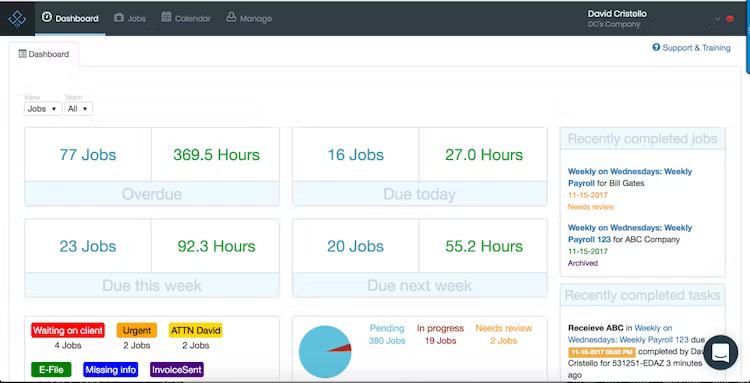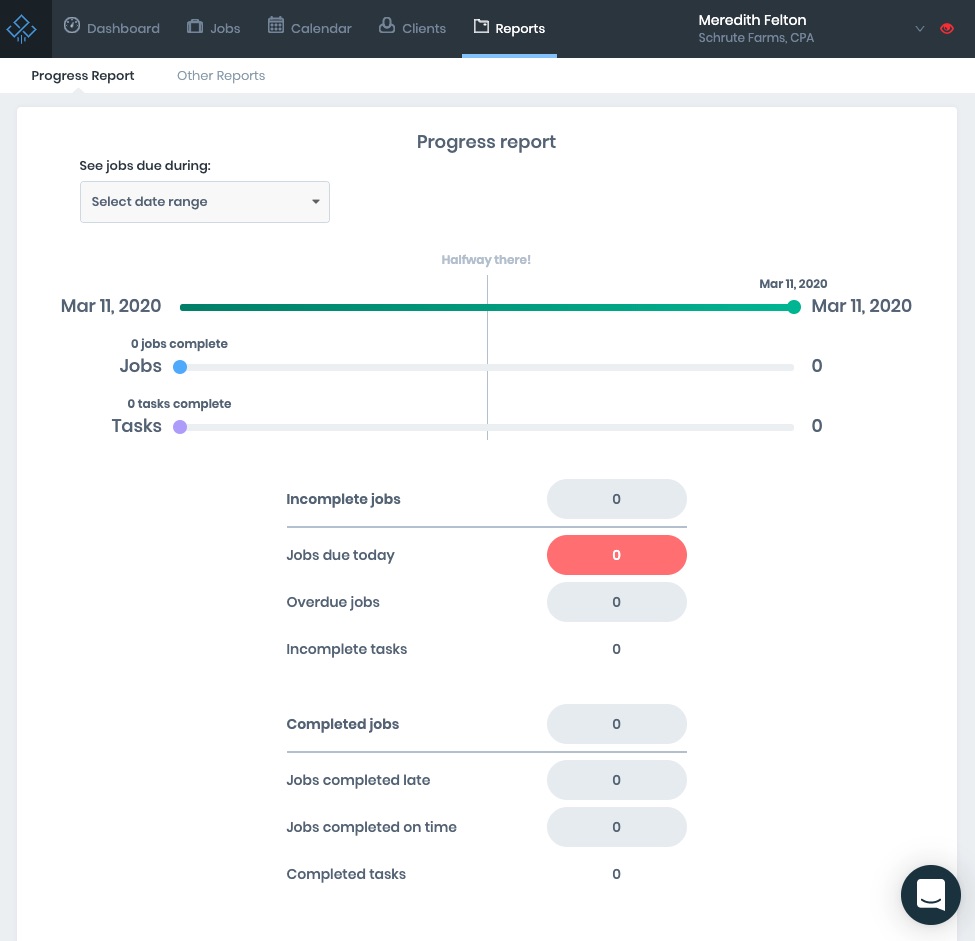Compare Asana vs Jetpack Workflow [2024 Edition]

The right workflow management software is a central building block to a successful accounting business. Whether your goal is to build bookkeeping workflow templates that can scale as you add a new client, or design standard operating procedures for other accounting client processes, you need a tool that’s intuitive to use, but also has the capability for customization.
Two of the best project management tools are Asana and Jetpack Workflow. Before you choose one and invest hours working on the setup process for your team, get to know the ins and outs of each option and ensure the software is a good fit for what you aim to accomplish.
What Do Asana and Jetpack Workflow Do?
When you’re managing multiple clients and team members, email and spreadsheets aren’t the best tools to run your business at maximum efficiency. And that’s where finding the best accounting project management software comes in.
Both Asana and Jetpack Workflow are virtual collaboration spaces designed to help you:
- Automate repeatable processes
- Design workflows that streamline production
- Keep track of the status of individual tasks
But while Asana and Jetpack Workflow are both designed with successful project management in mind, there are significant differences between the two solutions, particularly when it comes to implementing the software for accounting firms.
A Quick Overview of Each Tool
Asana is a well-known project management software company used by businesses in countless industries. That’s what it’s designed for. While it’s most popular with sales and marketing teams, software companies, IT firms, and non-profit organizations also use Asana to keep their teams on track.
One of Asana’s strengths is that it’s highly customizable, and can be used cross-functionally within large organizations. Team members who prefer seeing their work on a board can view it through their preferred settings, while those who like list view can opt for that perspective.
It helps leaders see where every team member is at with their tasks given its detailed reporting features. There’s also a way to build in automation for workflows, notifying people when it’s their turn to take the next step in a project.
Jetpack Workflow is a powerful tool designed specifically with accountants and bookkeepers in mind. Over 6,000 financial services professionals use the software for their firms and report saving an average of 10 hours per week.
Jetpack Workflow has an impressive template library of accounting- and bookkeeping-specific workflows that you can leverage to begin setting up your team in the software. On the other hand, if you have a specific process you follow, you can create your own template and apply it to every client you service.
The platform ensures both you and your team members have clear prioritization based on critical deadlines, and gives you a window into tasks completed within a set time frame. This helps leaders evaluate capacity and scale sustainably. You see when you have the bandwidth to take on new client work, and when it’s time to hire more help.
The Differences Between Asana and Jetpack Workflow
So what are the determining factors when choosing the best accounting project management software? Here are five key categories to rate each project management tool:
Features
Asana has all the basic project management features a workflow software needs. For example, you can create tasks and task dependencies. You can make mass updates to groups of tasks, and quickly set recurring tasks. It’s possible to drag and drop tasks, and easy to see personal or team-wide to-do lists.
You may notice that people who love Asana really love Asana. Part of this is because it overcomes one of the limitations of many project management tools: views. Everyone has a different way they like to visualize their work. Some love a Gantt chart, some like a Kanban board, and some like a regular list. Asana puts the power in the hands of the user to decide which view will give them the best picture of what they need to do, and when.
Asana can handle resource management and capacity planning as well. Progress monitoring, time tracking, and communication in the tool are all features that you can expect with Asana.
Jetpack Workflow delivers on the project management and task creation side as well. You can set up recurring tasks, create task dependencies, and automate critical deadlines.
One of the biggest strengths of Jetpack Workflow is the ability to draw on a very large template library. Pre-made templates are all based on what common services accounting firms and bookkeeping professionals offer to clients.
Another key feature of Jetpack Workflow is it’s designed to help accounting and bookkeeping professionals manage the business side, not just the execution of individual tasks. With that in mind, capacity planning tools that are built into the platform help you keep tabs on what your firm has completed, client by client, and what you need to do next to reach the next stage of growth.
Integrations
When evaluating the available integrations in any project management system, start by taking an inventory of what apps and programs you and your team already use to get work done.
Will your new tool take the place of these systems, or will you need your new software to work seamlessly with existing programs? It’s not about the tool that has the most integrations – it’s about finding the platform that has the right integrations, and the support on the backend to ensure it works flawlessly, as intended, once set up.
Asana makes this promise: you’ll only need one platform to manage all of your work. With that in mind, they’ve built integrations with hundreds of other apps. Some of the favorites include Outlook, Google Sheets, Slack, and Zoom. They also provide information about their API for developers building their own API.
Jetpack Workflow works well with Zapier. Using Zapier, users can easily integrate with over 2,000 apps in real time. You’re also able to sync with QuickBooks Online to quickly run billing, payroll, and send invoices without delay.
Ease of Use
The best project management system makes everything easier once you log in every day. How do these two options stack up, according to real users?
Asana scores high on the user interface scale because of the user’s ability to customize it on a personal level.
“Interface is user friendly. No need for lengthy tutorials on how to use this platform as it’s very intuitive and straightforward,” said a G2 reviewer.
But the real challenge with Asana isn’t found in the average daily user experience. It’s in the setup.
If you’re solely in charge of project management tool setup, prepare to spend a lot of time working to customize Asana to exactly what your firm needs. Because it’s designed to be accessible for so many teams in countless industries, accounting firms may meet roadblocks in the ramp-up phase.
Asana has 24/7 customer support, complete with a knowledge base where customers can self-help when issues arise.
Jetpack Workflow is designed for much faster onboarding, so a CPA, accountant, or bookkeeper can instantly start seeing the return on investment from the new tool. To go one step further, you can customize your package to include onboarding support from the Jetpack Workflow team.
Because of the verified templates built specifically for accounting workflows, financial firms have greater control over their pipeline of client work much faster.
“Using JetPack helps us keep track of all the big and small things so nothing falls through the cracks. The dashboard view showing overdue tasks, due today, this week, and next week is very helpful,” said a G2 reviewer.
Jetpack Workflow reports swift response times and the ability to contact the team via chat, phone, or email.
Price
Asana starts with a basic free plan. You can have up to 15 team members in your dashboard, unlimited tasks, and straightforward list, board, and calendar views. To access custom fields, private projects, custom templates, and many other features, you’ll need to upgrade to the premium plan, which is $13.49/user per month.
The next level up is the business account level, which includes more advanced integrations, workload planning, and other premier features. The cost is $30.49/user per month.
Jetpack Workflow offers two plan options. The baseline plan is called the “Organize” plan, running at $45/user per month. The “Scale” plan costs $49/user per month. Both plans include unlimited storage, making document management easy. Both plans have workflow features and the pre-loaded template library.
The main difference between the two plans is that the “Scale” plan includes capacity management and scheduling features. It’s a better fit for firms that are in growth mode and need additional monitoring and support as they take on new clients and team members. Jetpack Workflow also offers a 14-day free trial.
Wrapping Up
You’re going to notice a night and day difference when you select the right accounting practice management software. It’s no longer just on you to manage due dates – you have an automated partner on your side.
Asana is ideal if you’re not afraid of a potentially lengthy setup process, you have a clear view of exactly what you want to build, and you know you can devote the time to doing so.
Jetpack Workflow is a much better fit if you want a plug-and-play solution that allows you to instantly start implementing workflows across your business and manage the growth of your accounting or bookkeeping firm from both a macro and a micro-level.







